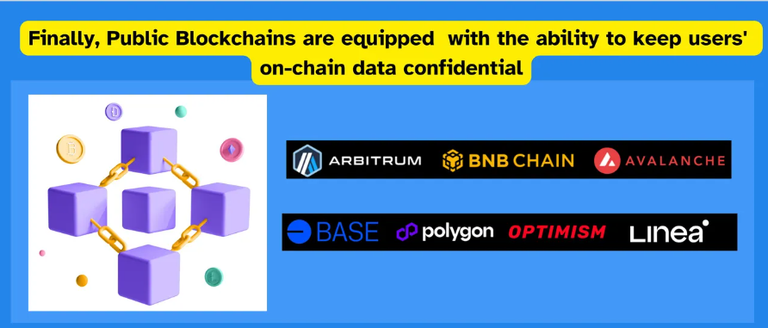
Created using Canva
Contemporary Blockchains have evolved with capabilities essential for ushering in the Web3 era
Now Blockchain technology is finally getting that base foundation intact, which was necessary all along to attract large-scale adoption of Web3 protocols.
First, we just had Bitcoin which showed us, the potential of Blockchain. Then we had Ethereum, which introduced smart contracts, which allowed for the development of dapp platforms capable of self-executing transactions automatically according to instructions coded into the smart contract.
Yet that era was a primitive stage, a lot of developments and advancements had to happen to develop scalable Blockchains, secure smart contracts while Blockchain’s decentralized ethos had to be kept intact. The Privacy element also needed to be incorporated into these Blockchains.
Unique Characteristics of Blockchain That Enhance Its Appeal
The allure of Blockchain has been its security and decentralization.
The process of every transaction of the user getting validated by the Blockchain system whether they be Proof of Work(POW) or Proof of Stake Blockchains (POS) provided functioning dapp protocols strong security guarantees.
This validation process of Blockchains ensured the integrity of data as data manipulation was impossible.
This validated data gets stored in nodes generally maintained by the validators of the network rather than in one centralized database maintained by a company.
This is why Blockchain technology is also known as distributed Ledger technology. All transaction records stored, stay permanently in a transparent fashion in Blockchain.
Blockchain is widely regarded as a promising technology having the property of censorship resistance as users data cannot be deleted, being recorded in various nodes.
All this was possible because Blockchain functions in a decentralized fashion with multiple nodes from around the world overseeing its 24 hours of uninterrupted functioning, as validators validate transactions, and secure the network.
Web3: Empowering Community Governance and Transparency Through Decentralization
One of Web3’s defining features is the involvement of token holders in protocol governance. In PoS and dPoS blockchains, stakers contribute to securing the network by delegating their stake to validators, while also holding governance rights.
Web3 protocols emphasize community involvement, making protocol development and management decisions more decentralized. Even treasury spending decisions are overseen by Decentralized Autonomous Organizations (DAOs), with proposals reviewed, discussed, and voted on by the community.
This transparency and stakeholder involvement is a unique aspect of Web3 that promotes decentralized decision-making.
Seamless and trustless interoperability between heterogeneous Blockchains is now a reality
There have been innumerable technological advancements that have made the Web3 landscape more interoperable these days.
First, interoperability was possible due to bridges, but nowadays there are cross-chain interoperability protocols that function in a trustless manner. Axelar, IBC are such types of cross-chain interoperability protocols.
So, native tokens from one blockchain can be transferred to another seamlessly, without wrapping and holding those tokens in a smart contract bridge custodied by centralized 3rd parties.
There are more developments happening in the realm to enable cross- chain swaps between heterogeneous Blockchains, although it is possible this development is already in place.
Enhanced Smart Contracts that are Modular, Secure and easy to write
Smart contracts too are more secure as they are complied in Cosmwasm framework. These are advanced elements. Smart Contracts have evolved to be modular, secure and easy to code as they can be written in multiple programming languages as long they compile to the byte code compatible to be processed by the Wasm virtual machine.
These days, it's easier to build dapps as well, there are custom libraries comprising of pre-written smart contracts to trigger specific functionality in dapp.
Anyone wanting to build a dapp can just deploy these smart contracts and power their Web3 protocol with required functionalities.
Web3 has privacy as Blockchains are equipped with privacy-powering technology

Another advancement in Web3 is that of data privacy. My earlier article had detailed how in general Blockchains were not capable of keeping user data confidential, but even that has changed.
Secret Network has a tried and tested privacy-preserving technology capable of encrypting user’s transactional data, validating this data without disclosing it, and then storing it in an encrypted form.
This is unique in Blockchain where all data is generally transparent and publically viewable on-chain!
Earlier privacy dapps could only be built on Secret but now Secret has made it possible for Web3 dapps build in other Blockchains to offer privacy-preserving functionalities.
Public Blockchains get a DeCC layer to provide them privacy functionalities
Now, Web3 protocols built in Blockchains like Ethereum, BNB, Polygon and other EVM-based virtual machines - Scroll, Moonbeam, Linea etc can provide data confidentiality to their users by providing privacy functionalities that only dapps built-in Privacy Blockchains like Secret could do before.
Right now, 20+ Blockchains have connected with Secret to enable Web3 protocols powered by them to connect with Secret Networks's Decentralised Confidential Computing (DeCC) technology that would power these Web3 protocols with privacy-preserving functionalities.
So, a NFT minted in a Binance Chain's build protocol can have confidential content that will only be accessible to the owner. Here the NFT minting is done in Secret using its DeCC technology, and then the encrypted NFT is sent back to the protocol.
Various other privacy features can be implemented in Web3 protocols build on public chains such as - private voting, sealed bid auctions, private DEFI, and secure Random Number Generation for gaming protocols.
These protocols on public transparent Blockchains are able to provide data privacy to users by connecting with Secret's DeCC technology, which powers privacy functionalities on the backend.
Now, Blockchains have got a DeCC layer that powers them with privacy-preserving functionalities.
More on this in another post.
Conclusion
Emerging Blockchains are turning out to be - seamlessly scalable, interoperable, secure and tuned to provide its users with data privacy.
All these advancements are preparing a strong ground for the large-scale adoption and usage of Web3 landscape.
Thank you for reading! Don’t forget to upvote this article if you enjoyed reading it!
Posted Using InLeo Alpha







